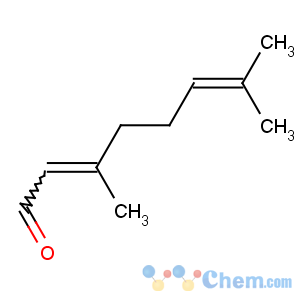Title: Citral
CAS Registry Number: 5392-40-5
CAS Name: 3,7-Dimethyl-2,6-octadienal
Molecular Formula: C10H16O
Molecular Weight: 152.23
Percent Composition: C 78.90%, H 10.59%, O 10.51%
Literature References: Constituent of many commercial oils such as lemon grass, verbena, lemon, and orange. Citral from natural sources is a 2:1 mixture of two geometric isomers geranial and neral. Isoln from lemongrass: F. W. Semmler,
Ber. 23, 2965 (1890); F. D. Dodge,
Am. Chem. J. 12, 553 (1890). Separation of isomers: Y. R. Naves,
Bull. Soc. Chim. Fr. 1952, 521. IR determn in lemon and orange oils: P. L. Mahia
et al., Food Chem. 46, 193 (1993). Stability in food emulsions and beverages: E. J. Freeburg
et al., Perfum. Flavor. 19(4), 23 (1994). Review of toxicity: D. L. J. Opdyke,
Food Cosmet. Toxicol. 17, 259-266 (1979); of reaction chemistry: R. K. Baslas, B. Gupta,
Indian Perfum. 32, 266-272 (1988). Comprehensive reviews: J. L. Simonsen,
The Terpenes vol. I, 83-100 (1947); P. Z. Bedoukian,
Perfumery and Flavoring Synthetics (Allured Publishing Corporation, Wheaton, IL, 3rd ed., 1986) pp 106-117.
Properties: Mobile pale yellow liquid having a strong lemon-like odor. d2525 0.885-0.891.
nD20 1.4860-1.4900. Flash point: 99.5°C (208°F). LD50 orally in rats: 4.96 g/kg (Opdyke).
Flash point: Flash point: 99.5°C (208°F)
Index of refraction: nD20 1.4860-1.4900
Density: d2525 0.885-0.891
Toxicity data: LD50 orally in rats: 4.96 g/kg (Opdyke)
Derivative Type: Geranial
CAS Registry Number: 141-27-5
Synonyms: Trans-citral; citral a
Properties: Light oily liquid with strong lemon odor. bp2.6 92-93°. d420 0.8888.
nD20 1.4898. Practically insol in water. Miscible with alc, ether, benzyl benzoate, diethyl phthalate, glycerol, propylene glycol, mineral oil, essential oils.
Boiling point: bp2.6 92-93°
Index of refraction: nD20 1.4898
Density: d420 0.8888
Derivative Type: Neral
CAS Registry Number: 106-26-3
Synonyms: cis-Citral; citral b
Properties: Light oily liquid with a lemon odor not as intense but sweeter than gerianal. bp2.6 91-92°. d420 0.8860.
nD20 1.4869. Solubilities same as gerianal.
Boiling point: bp2.6 91-92°
Index of refraction: nD20 1.4869
Density: d420 0.8860
Use: In the synthesis of vitamin A, ionone and methylionone. As a flavor and in perfumery for its citrus effect.

